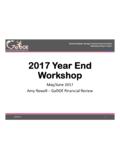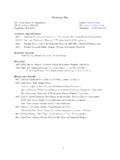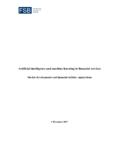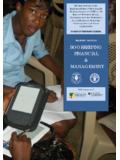Transcription of Rural women’s access to financial services
1 Rural women s access to financial services Credit, savings and insurance Diana Fletschner and Lisa Kenney ESA Working Paper No. 11-07 March 2011 Agricultural Development Economics Division The Food and Agriculture Organization of the United Nations 1 Rural women s access to financial services : c redit, savings and insurance1 Diana Fletschner Senior Gender Expert & Director of Research Landesa Center for Women's Land Rights and Lisa Kenney Evan School of Public Affairs University of Washington Abstract: This paper reviews Rural women s access to financial services , a key factor of successful Rural development strategies.
2 Designing appropriate financial products for women to be able to save, borrow and insure is essential to strengthen women s role as producers and widen the economic opportunities available to them. For this purpose it is essential to understand how context-specific legal rights, social norms, family responsibilities and women s access to and control over other resources shape their need for capital and their ability to obtain it. The paper argues that it is important that development strategies that aim to boost Rural women s productive capacity must enhance women s direct access to financial services , not mediated through their husbands.
3 A second benefit of improving women s direct access to and control over resources is that this leads to higher investments in human capital and have a stronger impact on children s health, nutrition and education with important long-term implications for families and societies. The paper details the new products and service delivery models introduced to address some of the constraints faced by women. These include technical innovations that improve access to existing financial services , changes in product design to better tailor products to women s preferences and constraints, and the development of new products such as microinsurance.
4 Key words: Women, gender, agriculture, financial resources, credit, insurance, intrahousehold allocation of resources JEL: D13, J16, Q14, Q18 Acknowledgements: We are grateful for comments from participants at the SOFA writers workshop, Sept. 2009, Rome. Any errors are the responsibility of the authors. ESA Working Papers represent work in progress and are circulated for discussion and comment. Views and opinions expressed here are those of the authors, and do not represent official positions of the Food and Agriculture Organization of the United Nations (FAO).
5 The designations employed and the presentation of material in this information product do not imply the expression of any opinion whatsoever on the part of FAO concerning the legal status of any country, territory, city or area or of its authorities, or concerning the delimitation of its frontiers or boundaries. 1 The research presented in this background paper to The State of Food and Agriculture 2010-2011, Women in agriculture: closing the gender gap in development was funded by FAO. The report is to be released on March 7 2011 and will be available at 2 Introduction Ensuring that farmers have adequate access to financial resources is a key tenet of successful Rural development strategies.
6 Policy-makers have long understood that Rural producers who cannot meet their needs for capital must settle for suboptimal production strategies. When producers are unable to make the necessary upfront investments or cannot bear additional risk, they have to forgo opportunities to boost their productivity, enhance their income and improve their well-being (Besley, 1995; Boucher et al., 2008, and; World Bank 2008a). Furthermore, without adequate access to loans or insurance, producers who face negative shocks, such as droughts, illness or a significant drop in the prices they receive, can lose some of the few assets they do have (Diagne and Zeller, 2001).
7 Conversely, producers who have access to well-designed credit, savings and insurance services can avail themselves of capital to finance the inputs, labour and equipment they need to generate income; can afford to invest in riskier but more profitable enterprises and asset portfolios; can reach markets more effectively; and can adopt more efficient strategies to stabilize their food consumption (Zeller et al., 1997). In the aggregate, broader access to financial services provides opportunities for improving the agricultural output, food security and economic vitality of entire communities and nations.
8 Despite this widely accepted notion, Rural financial programmes have been largely designed, crafted and implemented with the male head of household as the intended client and fail to recognize that women are active, productive and engaged economic agents with their own financial needs and constraints. Women constitute approximately half of the Rural labour force and, while not always counted, they are economically active in each subsector of the Rural economy. Even though millions of women throughout the world contribute to national agricultural output and family food security, detailed studies from Latin America, South Asia, and Sub-Saharan Africa consistently indicate that Rural women are more likely to be credit constrained than men of equivalent socio-economic conditions (Fletschner, 2009 and Diagne et al.)
9 , 2000). Well-designed products that enable women to adequately save, borrow and insure against unexpected shocks are therefore essential in any efforts to strengthen women s role as producers and expand the set of economic activities they can undertake, the scale at which they can operate and their ability to benefit from economic opportunities. Yet, with the 3 notable exception of a number of prominent microfinance programmes, the vast majority of Rural credit, savings and insurance programmes do not take into account that women s legal, social and economic position in their communities differ from men s.
10 Rural financial markets are not gender neutral To understand how commercial and state-owned development banks, cooperatives, traders and processors can improve their outreach to women, it is fundamental to identify how context-specific legal rights, social norms, family responsibilities and women s access to and control over other resources shape their need for capital and their ability to obtain it. Property rights and control over assets Legal regulations and customary rules often restrict women s access to and control over assets that can be accepted as collateral such as land or livestock.
















